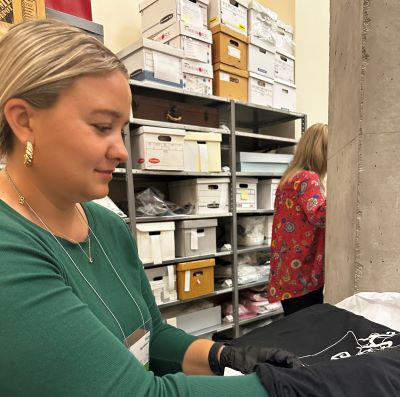
Paige Figanbaum is a PhD candidate in UNLV's history department. She successfully defended her dissertation described below on May 8, 2024, and will graduate this summer. Figanbaum was recently hired as Executive Director of the Nevada Preservation Foundation.
Tell us a little bit about the project (book, exhibit, article, documentary, report) you researched in Special Collections & Archives.
My dissertation entitled "From Extraction to Attraction: Case Studies in Historic Preservation, Heritage Tourism and Interpretation, 1945-2010" is an interdisciplinary work that explores four Nevada interpretive sites to demonstrate the intersections of Indigenous history, rural history, and the history of federal land management. The four interpretive sites include Virginia City’s National Historic Landmark District, the Walking Box Ranch located near Searchlight, the Springs Preserve in Las Vegas, and the Spring Mountain National Recreation Area near Mt. Charleston. In studying these sites, my dissertation provides new insight and analysis of Nevada's tourism industry. It draws on the theory and methods of public history to change understandings of desert land use and raise larger issues surrounding whose past is remembered and lost in the historical narratives. My interdisciplinary research confronts the complex discourses surrounding land use, land ownership, and identity formation in Nevada. As the state navigates increasing extreme water scarcity, economic woes, and environmental crises, my research offers a careful historical interpretation that has the potential to benefit site managers, government agencies, and Indigenous Nations.
How did you hear about Special Collections & Archives?
During my time in graduate school, I enrolled in HIST 710: The Professional Historian, which included a tour of Special Collections. This tour allowed us to explore the back accessioning and conservation rooms. I distinctly remember being shown the vast collection of restaurant menus.
What resources, collections, or materials from Special Collections & Archives were most impactful for your research?
Much of my dissertation research begins at UNLV's Special Collections. Among the collections, Elizabeth von Till and Claude N. Warren's Professional Papers stand out. This collection contains a wealth of materials relevant to both my second chapter on Las Vegas Springs Preserve and my third chapter on Spring Mountain Ranch State Park. Elizabeth Warren played a pivotal role in preservation efforts throughout Southern Nevada. Claude Warren's archaeological reconnaissance for the Big Springs or Las Vegas Springs Preserve was a fundamental part of placing the site on the National Register of Historic Places and its ongoing accessibility. Claude and Elizabeth Warren’s collection played a monumental role in helped me complete my dissertation.
How did you become interested in the topic(s) you wrote about?
I found it interesting that the federal government maintains 80.1% of Nevada's desert landscape. This starkly contrasts with the state of Iowa where I grew up where only .3% of land is federally managed. This huge difference sparked my curiosity about how communities, including Las Vegas, and rural areas like Searchlight, navigate their relationships with such a substantial federal government presence.
What surprised you the most about your research in Special Collections & Archives?
The number of resources available through the Special Collections digital portal. The amount of primary source materials I could research during the pandemic through UNLV’s digital collections certainly saved me on preliminary research for my dissertation and seminar papers. Specifically, oral histories such as Rex Bell Jr.’s experience growing up on the Walking Box Ranch.
What advice would you give to other authors/researchers using Special Collections & Archives? (Otherwise known as what I wish someone had told me before I visited Special Collections & Archives)
Before visiting Special Collections, I would suggest reviewing the finding aids. This will help you narrow down the specific resources you need to focus on when you're in the archives. When conducting research in Special Collections & Archives, it's essential to establish a systematic approach. Take notes including proper citations, significant quotes, analysis, and questions as you examine the materials. These notes will prove invaluable during the heavy writing stages of your project.
How did your research in Special Collections & Archives change your perceptions about Las Vegas?
Having not grown up in Las Vegas, I initially held a limited view of Nevada's history, primarily revolving around the city's development as one of the entertainment capitals of the world. However, my perspective changed after exploring UNLV's Special Collections. While I did learn about the captivating history of the Strip, I also gained a more comprehensive understanding of Las Vegas' dynamic history. This history included Las Vegas’ wide range of architectural styles, including Neo-Expressionist, Formalism, and Bungalow architecture. I also delved into the fascinating ranching history of places like Spring Mountain Ranch and Walking Box Ranch. Researching Las Vegas and Nevada’s diverse history made me appreciate the beautiful desert landscape.
What are you working on next?
I had the opportunity to collaborate with the Nevada Preservation Foundation on developing tours for the Las Vegas Home + History 2023 event. These tours showcase the city's historic neighborhoods, such as Scotch 80s, Beverly Green, and the Huntridge. The architectural records available in UNLV Special Collections played a crucial role in uncovering the rich history of these neighborhoods, highlighting significant homes, and showcasing the remarkable architectural diversity that defines Las Vegas.


